Write an Equation and Then Solve It Art Specific Pionts
Graphs
33 Graph Linear Equations in Two Variables
Learning Objectives
By the cease of this section, y'all will be able to:
- Recognize the human relationship between the solutions of an equation and its graph.
- Graph a linear equation by plotting points.
- Graph vertical and horizontal lines.
Recognize the Relationship Between the Solutions of an Equation and its Graph
In the previous section, we found several solutions to the equation ![]() . They are listed in (Figure). And then, the ordered pairs
. They are listed in (Figure). And then, the ordered pairs ![]() ,
, ![]() , and
, and ![]() are some solutions to the equation
are some solutions to the equation ![]() . We tin plot these solutions in the rectangular coordinate organisation as shown in (Figure).
. We tin plot these solutions in the rectangular coordinate organisation as shown in (Figure).
| | ||
| | | |
| 0 | three | |
| two | 0 | |
| i | | |
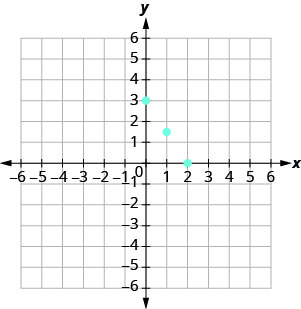
Notice how the points line up perfectly? We connect the points with a line to get the graph of the equation ![]() . See (Figure). Notice the arrows on the ends of each side of the line. These arrows signal the line continues.
. See (Figure). Notice the arrows on the ends of each side of the line. These arrows signal the line continues.
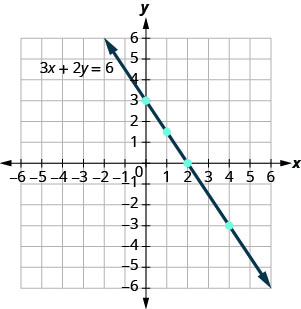
Every point on the line is a solution of the equation. Also, every solution of this equation is a bespeak on this line. Points non on the line are not solutions.
Observe that the bespeak whose coordinates are ![]() is on the line shown in (Effigy). If yous substitute
is on the line shown in (Effigy). If yous substitute ![]() and
and ![]() into the equation, you find that it is a solution to the equation.
into the equation, you find that it is a solution to the equation.
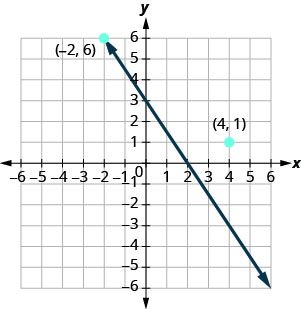

So the point ![]() is a solution to the equation
is a solution to the equation ![]() . (The phrase "the betoken whose coordinates are
. (The phrase "the betoken whose coordinates are ![]() " is often shortened to "the point
" is often shortened to "the point ![]() .")
.")
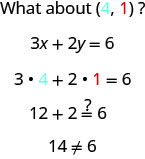
And so ![]() is not a solution to the equation
is not a solution to the equation ![]() . Therefore, the betoken
. Therefore, the betoken ![]() is not on the line. Run across (Effigy). This is an example of the saying, "A picture is worth a grand words." The line shows you all the solutions to the equation. Every point on the line is a solution of the equation. And, every solution of this equation is on this line. This line is called the graph of the equation
is not on the line. Run across (Effigy). This is an example of the saying, "A picture is worth a grand words." The line shows you all the solutions to the equation. Every point on the line is a solution of the equation. And, every solution of this equation is on this line. This line is called the graph of the equation ![]() .
.
Graph of a Linear Equation
The graph of a linear equation ![]() is a line.
is a line.
- Every point on the line is a solution of the equation.
- Every solution of this equation is a point on this line.
The graph of ![]() is shown.
is shown.
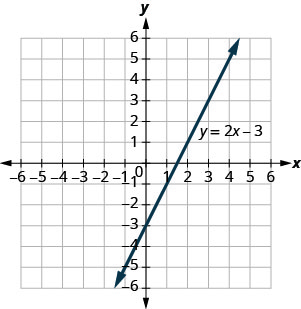
For each ordered pair, make up one's mind:
ⓐ Is the ordered pair a solution to the equation?
ⓑ Is the point on the line?
A ![]() B
B ![]() C
C ![]() D
D ![]()
Utilize the graph of ![]() to determine whether each ordered pair is:
to determine whether each ordered pair is:
- a solution to the equation.
- on the line.
ⓐ ![]() ⓑ
ⓑ ![]()
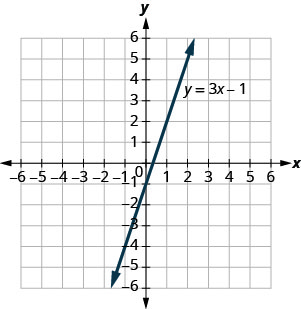
ⓐ yeah, yesⓑ aye, yeah
Use graph of ![]() to decide whether each ordered pair is:
to decide whether each ordered pair is:
- a solution to the equation
- on the line
ⓐ ![]() ⓑ
ⓑ ![]()

ⓐ no, noⓑ aye, yep
Graph a Linear Equation by Plotting Points
There are several methods that can be used to graph a linear equation. The method nosotros used to graph ![]() is chosen plotting points, or the Point–Plotting Method.
is chosen plotting points, or the Point–Plotting Method.
How To Graph an Equation By Plotting Points
Graph the equation ![]() past plotting points.
past plotting points.
Graph the equation by plotting points: ![]() .
.
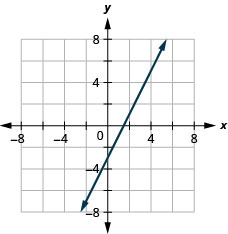
Graph the equation by plotting points: ![]() .
.
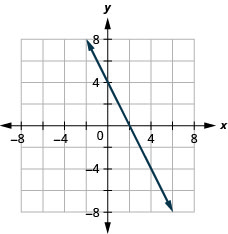
The steps to take when graphing a linear equation by plotting points are summarized beneath.
Graph a linear equation by plotting points.
- Find 3 points whose coordinates are solutions to the equation. Organize them in a table.
- Plot the points in a rectangular coordinate arrangement. Check that the points line upwards. If they do not, carefully check your work.
- Draw the line through the 3 points. Extend the line to make full the grid and put arrows on both ends of the line.
Information technology is true that information technology merely takes two points to determine a line, but it is a good habit to use iii points. If yous only plot two points and one of them is incorrect, you tin can still describe a line but it will not represent the solutions to the equation. It will be the wrong line.
If you use three points, and one is incorrect, the points will non line up. This tells you something is wrong and you demand to check your work. Look at the difference betwixt part (a) and part (b) in (Figure).
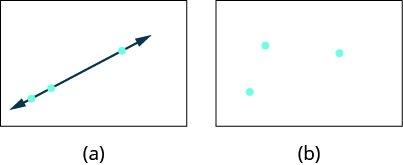
Let's do some other instance. This fourth dimension, nosotros'll show the concluding two steps all on one grid.
Graph the equation ![]() .
.
Solution
Notice iii points that are solutions to the equation. Here, again, it's easier to choose values for ![]() . Do yous see why?
. Do yous see why?
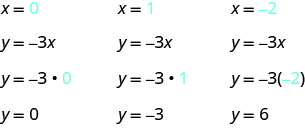
We list the points in (Figure).
| | ||
| | | |
| 0 | 0 | |
| ane | | |
| | 6 | |
Plot the points, bank check that they line up, and draw the line.
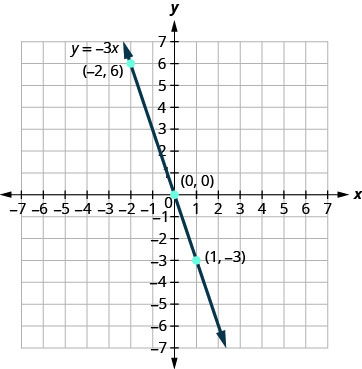
Graph the equation past plotting points: ![]() .
.
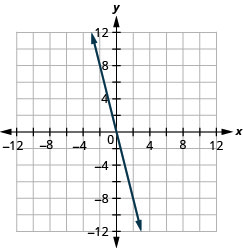
Graph the equation by plotting points: ![]() .
.
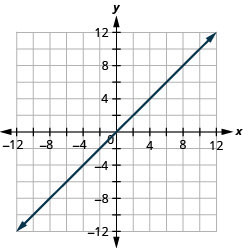
When an equation includes a fraction as the coefficient of ![]() , nosotros can all the same substitute any numbers for
, nosotros can all the same substitute any numbers for ![]() . But the math is easier if we make 'skillful' choices for the values of
. But the math is easier if we make 'skillful' choices for the values of ![]() . This fashion nosotros volition avert fraction answers, which are hard to graph precisely.
. This fashion nosotros volition avert fraction answers, which are hard to graph precisely.
Graph the equation ![]() .
.
Graph the equation ![]() .
.
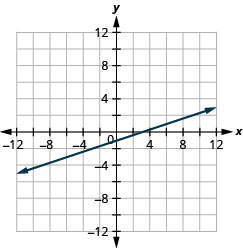
Graph the equation ![]() .
.
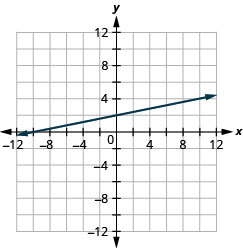
So far, all the equations we graphed had ![]() given in terms of
given in terms of ![]() . Now we'll graph an equation with
. Now we'll graph an equation with ![]() and
and ![]() on the same side. Let's run into what happens in the equation
on the same side. Let's run into what happens in the equation ![]() . If
. If ![]() what is the value of
what is the value of ![]() ?
?

This bespeak has a fraction for the x– coordinate and, while nosotros could graph this bespeak, information technology is hard to be precise graphing fractions. Recollect in the instance ![]() , we carefully chose values for
, we carefully chose values for ![]() and so as not to graph fractions at all. If nosotros solve the equation
and so as not to graph fractions at all. If nosotros solve the equation ![]() for
for ![]() , information technology will be easier to find three solutions to the equation.
, information technology will be easier to find three solutions to the equation.
![]()
The solutions for ![]() ,
, ![]() , and
, and ![]() are shown in the (Figure). The graph is shown in (Figure).
are shown in the (Figure). The graph is shown in (Figure).
| | ||
| | | |
| 0 | 3 | |
| 1 | 1 | |
| | v | |
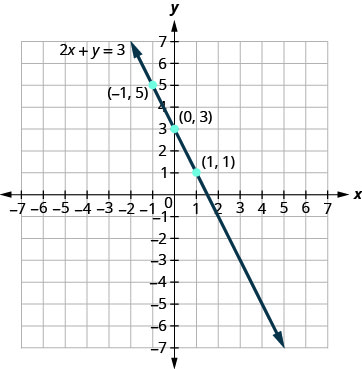
Tin can you locate the signal ![]() , which we found by letting
, which we found by letting ![]() , on the line?
, on the line?
Graph the equation ![]() .
.
Graph the equation ![]() .
.
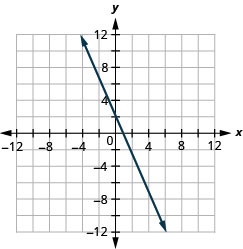
Graph the equation ![]() .
.
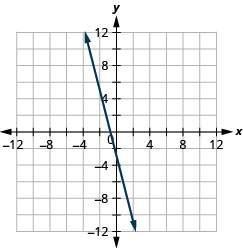
If you can choose whatsoever three points to graph a line, how will you know if your graph matches the one shown in the answers in the book? If the points where the graphs cross the x– and y-axis are the same, the graphs match!
The equation in (Figure) was written in standard class, with both ![]() and
and ![]() on the same side. Nosotros solved that equation for
on the same side. Nosotros solved that equation for ![]() in just one step. Just for other equations in standard form it is not that easy to solve for
in just one step. Just for other equations in standard form it is not that easy to solve for ![]() , so we will leave them in standard form. We tin can yet find a offset point to plot past letting
, so we will leave them in standard form. We tin can yet find a offset point to plot past letting ![]() and solving for
and solving for ![]() . We tin can plot a second point by letting
. We tin can plot a second point by letting ![]() and and then solving for
and and then solving for ![]() . Then nosotros will plot a 3rd point by using some other value for
. Then nosotros will plot a 3rd point by using some other value for ![]() or
or ![]() .
.
Graph the equation ![]() .
.
Graph the equation ![]() .
.
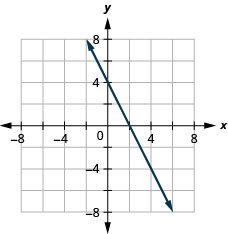
Graph the equation ![]() .
.
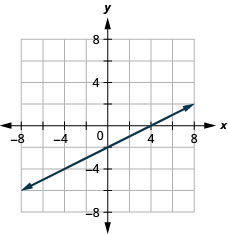
Graph Vertical and Horizontal Lines
Tin can we graph an equation with only one variable? Merely ![]() and no
and no ![]() , or just
, or just ![]() without an
without an ![]() ? How will nosotros make a table of values to go the points to plot?
? How will nosotros make a table of values to go the points to plot?
Allow'due south consider the equation ![]() . This equation has but one variable,
. This equation has but one variable, ![]() . The equation says that
. The equation says that ![]() is always equal to
is always equal to ![]() , then its value does non depend on
, then its value does non depend on ![]() . No thing what
. No thing what ![]() is, the value of
is, the value of ![]() is e'er
is e'er ![]() .
.
And then to make a table of values, write ![]() in for all the
in for all the ![]() values. And then cull any values for
values. And then cull any values for ![]() . Since
. Since ![]() does non depend on
does non depend on ![]() , you can choose whatever numbers you similar. Only to fit the points on our coordinate graph, we'll use 1, 2, and 3 for the y-coordinates. Run into (Effigy).
, you can choose whatever numbers you similar. Only to fit the points on our coordinate graph, we'll use 1, 2, and 3 for the y-coordinates. Run into (Effigy).
| | ||
| | | |
| | i | |
| | ii | |
| | 3 | |
Plot the points from (Figure) and connect them with a straight line. Notice in (Effigy) that we accept graphed a vertical line.

Vertical Line
A vertical line is the graph of an equation of the form ![]() .
.
The line passes through the x-centrality at ![]() .
.
Graph the equation ![]() .
.
Graph the equation ![]() .
.
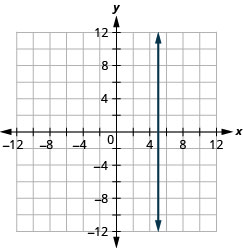
Graph the equation ![]() .
.
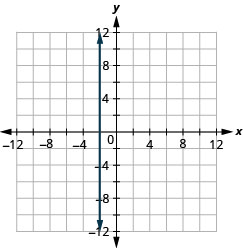
What if the equation has ![]() but no
but no ![]() ? Let's graph the equation
? Let's graph the equation ![]() . This fourth dimension the y– value is a constant, so in this equation,
. This fourth dimension the y– value is a constant, so in this equation, ![]() does not depend on
does not depend on ![]() . Fill in four for all the
. Fill in four for all the ![]() 's in (Effigy) and then choose whatever values for
's in (Effigy) and then choose whatever values for ![]() . We'll use 0, 2, and 4 for the x-coordinates.
. We'll use 0, 2, and 4 for the x-coordinates.
| | ||
| | | |
| 0 | 4 | |
| two | 4 | |
| 4 | 4 | |
The graph is a horizontal line passing through the y-axis at iv. See (Figure).
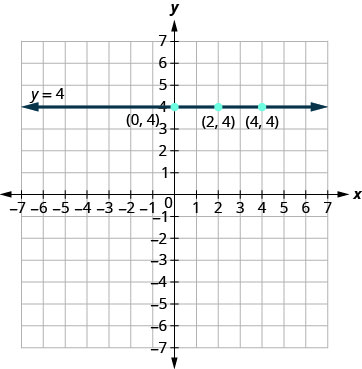
Horizontal Line
A horizontal line is the graph of an equation of the form ![]() .
.
The line passes through the y-axis at ![]() .
.
Graph the equation ![]()
Graph the equation ![]() .
.
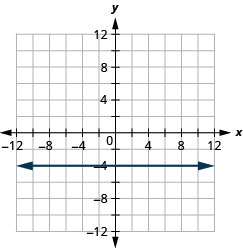
Graph the equation ![]() .
.
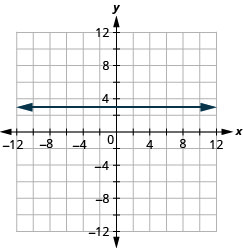
The equations for vertical and horizontal lines expect very similar to equations like ![]() What is the divergence betwixt the equations
What is the divergence betwixt the equations ![]() and
and ![]() ?
?
The equation ![]() has both
has both ![]() and
and ![]() . The value of
. The value of ![]() depends on the value of
depends on the value of ![]() . The y-coordinate changes according to the value of
. The y-coordinate changes according to the value of ![]() . The equation
. The equation ![]() has simply one variable. The value of
has simply one variable. The value of ![]() is constant. The y-coordinate is always 4. It does not depend on the value of
is constant. The y-coordinate is always 4. It does not depend on the value of ![]() . Come across (Figure).
. Come across (Figure).
| | | |||||
| | | | | | | |
| 0 | 0 | | 0 | 4 | | |
| 1 | 4 | | 1 | 4 | | |
| 2 | 8 | | 2 | four | | |
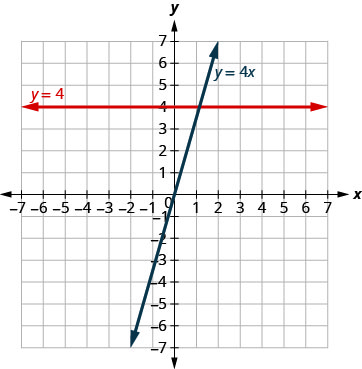
Find, in (Figure), the equation ![]() gives a slanted line, while
gives a slanted line, while ![]() gives a horizontal line.
gives a horizontal line.
Graph ![]() and
and ![]() in the same rectangular coordinate system.
in the same rectangular coordinate system.
Graph ![]() and
and ![]() in the aforementioned rectangular coordinate system.
in the aforementioned rectangular coordinate system.
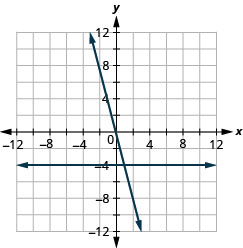
Graph ![]() and
and ![]() in the same rectangular coordinate system.
in the same rectangular coordinate system.
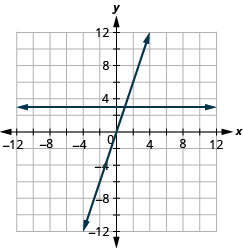
Central Concepts
- Graph a Linear Equation past Plotting Points
- Find three points whose coordinates are solutions to the equation. Organize them in a table.
- Plot the points in a rectangular coordinate organization. Check that the points line upward. If they do not, carefully check your work!
- Draw the line through the three points. Extend the line to fill the grid and put arrows on both ends of the line.
Practice Makes Perfect
Recognize the Relationship Between the Solutions of an Equation and its Graph
In the following exercises, for each ordered pair, decide:
ⓐ Is the ordered pair a solution to the equation?ⓑ Is the indicate on the line?
ⓐ yes; noⓑ no; noⓒ yes; yepⓓ yeah; aye
ⓐ yes; yesⓑ yes; ayeⓒ yeah; yesⓓ no; no
Graph a Linear Equation by Plotting Points
In the following exercises, graph past plotting points.
![]()
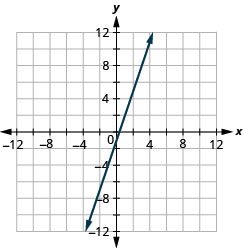
![]()
![]()
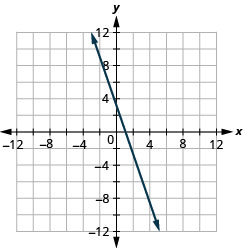
![]()
![]()
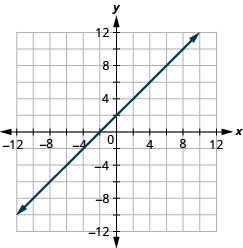
![]()
![]()
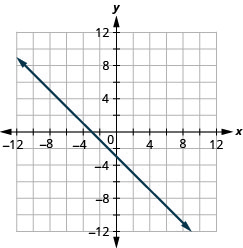
![]()
![]()
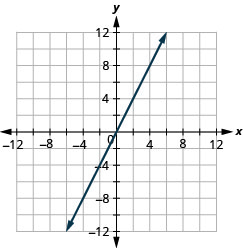
![]()
![]()

![]()
![]()
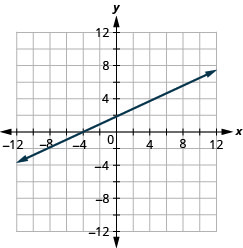
![]()
![]()
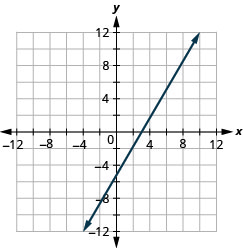
![]()
![]()
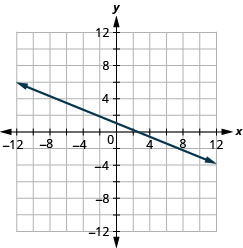
![]()
![]()
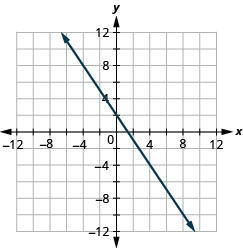
![]()
![]()
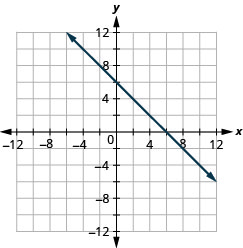
![]()
![]()
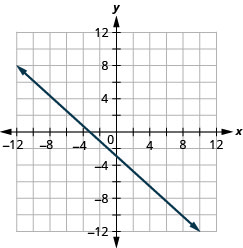
![]()
![]()
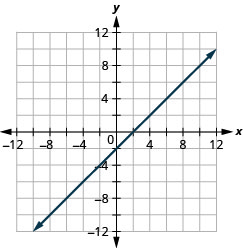
![]()
![]()
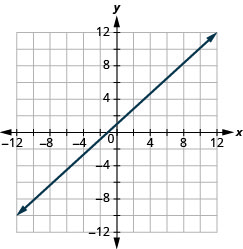
![]()
![]()

![]()
![]()
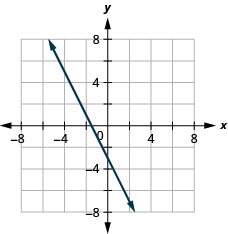
![]()
![]()
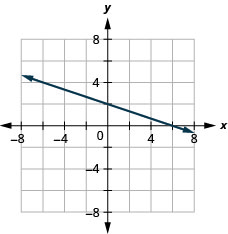
![]()
![]()
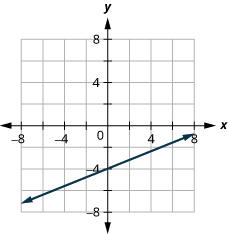
![]()
![]()
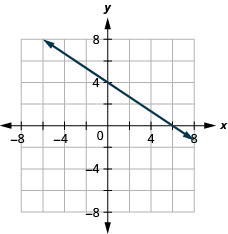
![]()
![]()
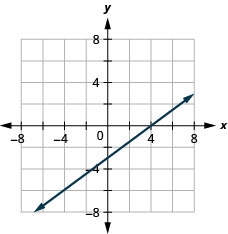
![]()
![]()
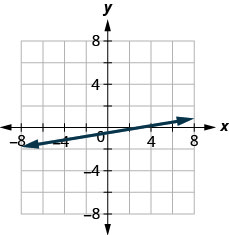
![]()
![]()
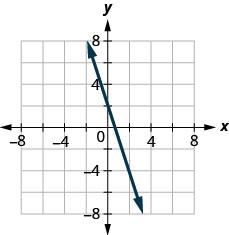
![]()
Graph Vertical and Horizontal Lines
In the following exercises, graph each equation.
![]()
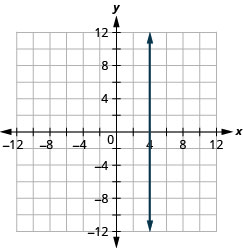
![]()
![]()
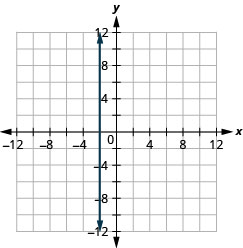
![]()
![]()
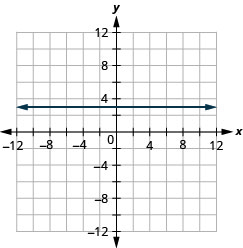
![]()
![]()
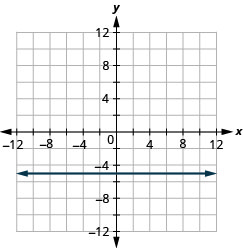
![]()
![]()
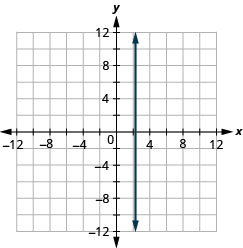
![]()
![]()
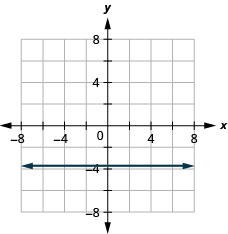
![]()
In the following exercises, graph each pair of equations in the aforementioned rectangular coordinate system.
![]() and
and ![]()
![]() and
and ![]()
Mixed Exercise
In the following exercises, graph each equation.
![]()
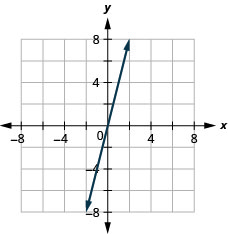
![]()
![]()
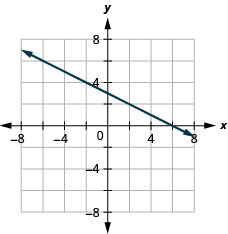
![]()
![]()
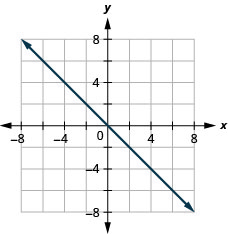
![]()
![]()
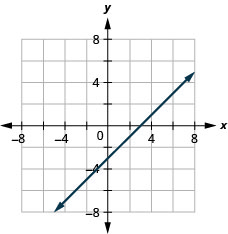
![]()
![]()
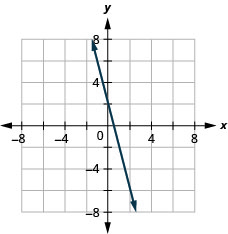
![]()
![]()
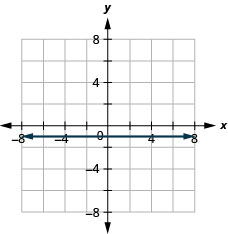
![]()
![]()
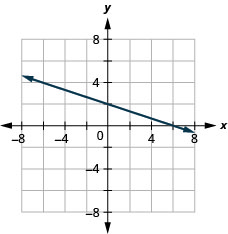
![]()
![]()
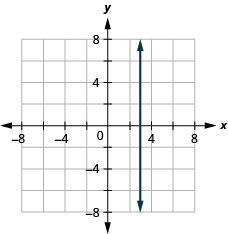
![]()
Everyday Math
Motor home toll. The Robinsons rented a motor home for one calendar week to go on holiday. It cost them ?594 plus ?0.32 per mile to rent the motor dwelling, then the linear equation ![]() gives the cost,
gives the cost, ![]() , for driving
, for driving ![]() miles. Calculate the rental toll for driving 400, 800, and 1200 miles, so graph the line.
miles. Calculate the rental toll for driving 400, 800, and 1200 miles, so graph the line.
?722, ?850, ?978
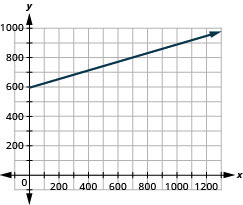
Writing Exercises
Explicate how you lot would choose 3 x– values to brand a tabular array to graph the line ![]() .
.
Answers will vary.
What is the difference between the equations of a vertical and a horizontal line?
Self Bank check
ⓐ Afterward completing the exercises, use this checklist to evaluate your mastery of the objectives of this section.

ⓑ After reviewing this checklist, what will you lot exercise to get confident for all goals?
phillipsthatimbers.blogspot.com
Source: https://opentextbc.ca/elementaryalgebraopenstax/chapter/graph-linear-equations-in-two-variables/
0 Response to "Write an Equation and Then Solve It Art Specific Pionts"
Post a Comment